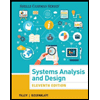
Concept explainers
Explanation of Solution
Machine learning will change systems development projects:
In certain tasks machines are more accurate and faster than humans. Developers face difficulty to write software that can identify face, translate content from one language to another and determining which new stories are relevant to individual users; but these applications are increasingly relevant and profitable.
Developers can create these apps using machine learning by training the system to make the correct decision to lead to the correct outcome and developers need not write codes for it.
Using Fetch! as an example mention the reason for which training will be an integral part of systems development:
Fetch! is a Microsoft application which takes any image and identifies a dog breed which resembles the photo. Microsoft developers used Machine learning to train Fetch to correctly identify dog breed.
- The developers trained fetch by constantly giving fetch different images and letting fetch know when it identified the correct breed and following this procedure fetch learned.
- This process created the complex
algorithms that fetch uses to analyze images. - This shows training will be an integral part of systems development.
The reason for which one is most likely to be involved in systems development project during professional career:
It can be said that Software runs the world and current employers depend on software to make money...
Want to see the full answer?
Check out a sample textbook solution
Chapter 12 Solutions
EBK USING MIS
- In a shopping cart, there are various items, which can either belong to the category of household items or electronic items. The following UML diagram illustrates the relationship between items, household items, and electronic items. //Implementation Class public class ShoppingCart{ public static void main(String[] args){ final int MAX_ITEM = 50; Item cart = new Item[MAX_ITEM]; addItem(cart); // populate the item array printItem(cart); } } Considering that all the data definition classes and the implementation class are complete, which of the following Object-Oriented Programming (OOP) concepts do you need to use in the above context? i) Polymorphism ii) Method Overloading iii) Method Overriding iv) Dynamic Binding v) Abstract Class Explain, using course terminology, how you would use any of the above concepts to model the given scenario.arrow_forwardAnswer this JAVA OOP question below: An Employee has a name, employee ID, and department. An Employee object must be created with all its attributes. The UML diagram is provided below: - name: String - employeeId: String - department: String + Employee(name: String, employeeId: String, department: String) + setName(name: String): void + setEmployeeId(employeeId: String): void + setDepartment(department: String): void + getName(): String + getEmployeeId(): String + getDepartment(): String + toString(): String A faculty is an Employee with an additional field String field: rank public class TestImplementation{ public static void main(String[] args){ Employee[] allEmployee = new Employee[100]; // create an employee object with name Tom Evan, employee ID 001 and department IST and store it in allEmployee // create a faculty object with name Adam Scott, employee ID 002, department IST and rank Professor and store it in allEmployee } }arrow_forwardPlease answer this JAVA OOP question that is given below: An Employee has a name, employee ID, and department. An Employee object must be created with all its attributes. The UML diagram is provided below: - name: String - employeeId: String - department: String + Employee(name: String, employeeId: String, department: String) + setName(name: String): void + setEmployeeId(employeeId: String): void + setDepartment(department: String): void + getName(): String + getEmployeeId(): String + getDepartment(): String + toString(): String A faculty is an Employee with an additional field String field: rank Assuming the Employee class is fully implemented, define a Professor class in Java with the following: A toString() method that includes both the inherited attributes and the specializationarrow_forward
- Please answer JAVA OOP question below: An Employee has a name, employee ID, and department. An Employee object must be created with all its attributes. The UML diagram is provided below: - name: String - employeeId: String - department: String + Employee(name: String, employeeId: String, department: String) + setName(name: String): void + setEmployeeId(employeeId: String): void + setDepartment(department: String): void + getName(): String + getEmployeeId(): String + getDepartment(): String + toString(): String A faculty is an Employee with an additional field String field: rank Assuming the Employee class is fully implemented, define a Professor class in Java with the following: Instance variable(s) A Constructorarrow_forwardDevelop a C++ program that execute the operation as stated by TM for addition of two binary numbers (see attached image). Your code should receive two binary numbers and output the resulting sum (also in binary). Make sure your code mimics the TM operations (dealing with the binary numbers as a string of characters 1 and 0, and following the logic to increase the first number and decreasing the second one. Try your TM for the following examples: 1101 and 101, resulting 10010; and 1101 and 11, resulting 10000.arrow_forwardI need to define and discuss the uses of one monitoring or troubleshooting tool in Windows Server 2019. thank youarrow_forward
- I would likr toget help with the following concepts: - Windows Server features - Windows Server versus Windows 10 used as a client-server networkarrow_forwardI need to define and discuss the uses of one monitoring or troubleshooting tool in Windows Server 2019. thank youarrow_forwardWhy is planning for the retirement system and transition critical?arrow_forward
 Principles of Information Systems (MindTap Course...Computer ScienceISBN:9781285867168Author:Ralph Stair, George ReynoldsPublisher:Cengage Learning
Principles of Information Systems (MindTap Course...Computer ScienceISBN:9781285867168Author:Ralph Stair, George ReynoldsPublisher:Cengage Learning Fundamentals of Information SystemsComputer ScienceISBN:9781305082168Author:Ralph Stair, George ReynoldsPublisher:Cengage Learning
Fundamentals of Information SystemsComputer ScienceISBN:9781305082168Author:Ralph Stair, George ReynoldsPublisher:Cengage Learning Systems Analysis and Design (Shelly Cashman Serie...Computer ScienceISBN:9781305494602Author:Scott Tilley, Harry J. RosenblattPublisher:Cengage Learning
Systems Analysis and Design (Shelly Cashman Serie...Computer ScienceISBN:9781305494602Author:Scott Tilley, Harry J. RosenblattPublisher:Cengage Learning Fundamentals of Information SystemsComputer ScienceISBN:9781337097536Author:Ralph Stair, George ReynoldsPublisher:Cengage Learning
Fundamentals of Information SystemsComputer ScienceISBN:9781337097536Author:Ralph Stair, George ReynoldsPublisher:Cengage Learning Management Of Information SecurityComputer ScienceISBN:9781337405713Author:WHITMAN, Michael.Publisher:Cengage Learning,
Management Of Information SecurityComputer ScienceISBN:9781337405713Author:WHITMAN, Michael.Publisher:Cengage Learning,





